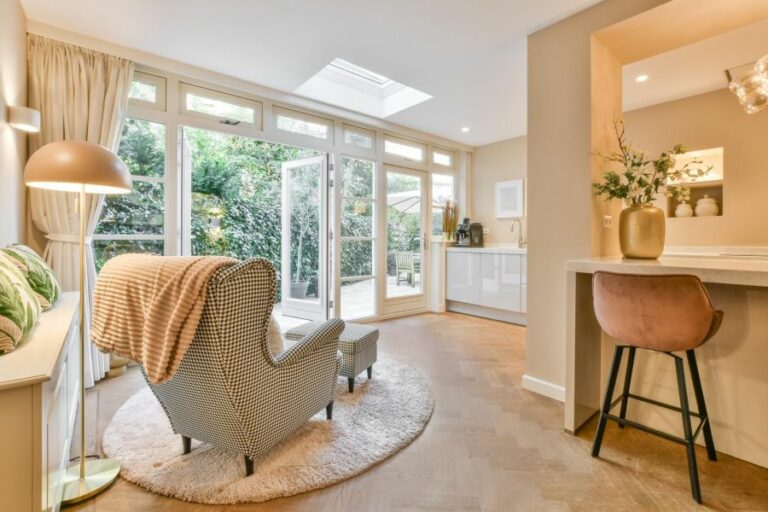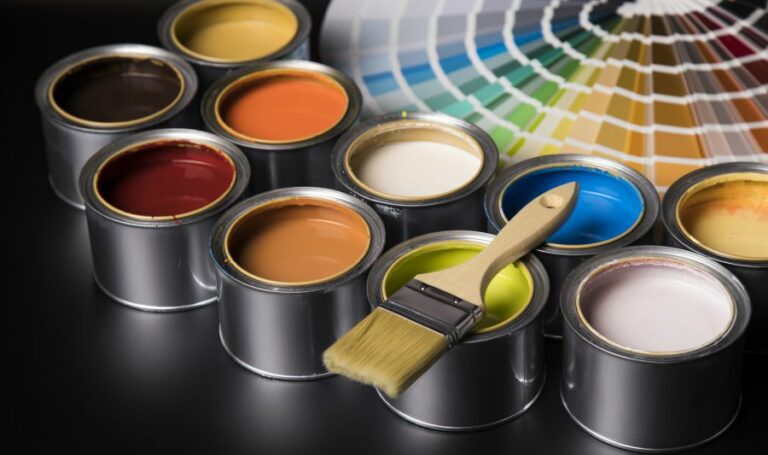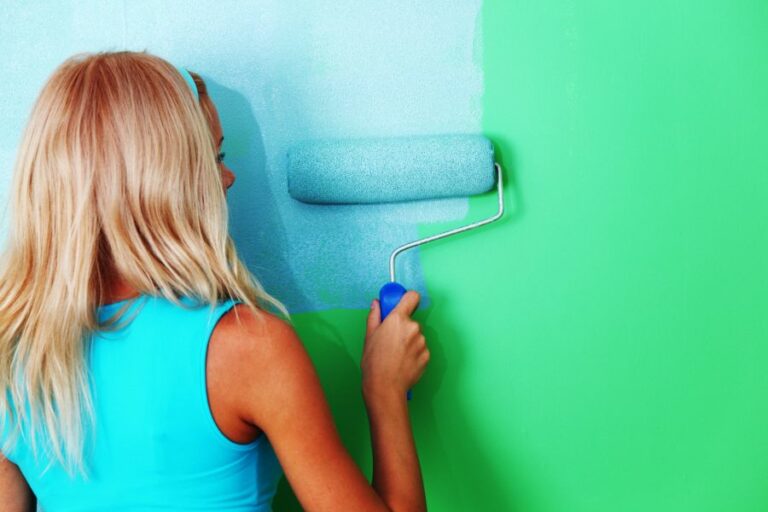Indoor Painting Dos And Don’ts For Newbies. What Pros Say
Ready to transform your living space with a fresh coat of paint? You’ve come to the right place! As a newbie to indoor painting, it’s crucial to learn the dos and don’ts before diving into your project. We’ve got you covered with expert tips and tricks that will guarantee a smooth and flawless finish for your walls.
Indoor painting dos and don’ts for newbies:
For indoor painting newbies, do: clean and prep walls, repair surface imperfections, invest in quality paint and brushes, prime walls, use a “W” technique for rolling, and remove painter’s tape carefully. Don’t: skip surface repairs, overload brushes or rollers, or rush the drying process. Proper preparation and patience are crucial for a successful painting project.

Ready to give your home a fresh new look with a paint job but unsure how to start? We’ve got you covered! Dive into our comprehensive guide on indoor painting dos and don’ts for newbies. Read on for expert tips and techniques that’ll help you achieve a flawless finish, stress-free!
Contents
- 1 Interior Painting Tips: Do’s and Don’ts for Beginners
- 2 Interior Wall Painting: Mistakes to Avoid
- 3 Key Steps to Take When Painting a Room
- 3.1 • Prepare the Room for Painting
- 3.2 • Choose the Right Paint and Tools
- 3.3 • Clean and Repair the Surfaces
- 3.4 • Safeguard the Trim, Fixtures, and Baseboards
- 3.5 • Prime The Walls
- 3.6 • Plan Your Painting Strategy
- 3.7 • Use Proper Painting Techniques
- 3.8 • Allow the Paint to Dry
- 3.9 • Clean Up and Enjoy Your Newly Painted Room
- 4 Beginner’s Guide to Room Painting: Step-by-Step
- 5 Essential Do’s and Don’ts for Successful Paint Application
Interior Painting Tips: Do’s and Don’ts for Beginners
Painting the inside of your home can be a fun and rewarding experience. But, it can also be challenging, especially for those who are new to the world of interior painting.
• Preparation is Key
– Do: Clean and Prep Your Walls
Before beginning any painting project, it’s crucial to clean and prep your walls. This step includes removing any dirt, grease, or grime from the surfaces to ensure the paint adheres properly. A simple solution of warm water and a few drops of dish soap should be sufficient for this task.
After scrubbing down the walls, make sure to rinse off any soap residue and allow the walls to dry completely before moving on.
– Don’t: Skip Surface Repairs
It’s essential to address any holes, cracks, or other imperfections in your walls before painting. Use a putty knife and an appropriate filler to repair small issues, and be sure to sand the area smoothly once the filler is dry.
Skipping these repairs will result in a less-than-professional finish, and you’ll likely have to invest additional time and money to fix these problems down the road.
• Choose the Right Materials
– Do: Invest in Good-Quality Paint and Brushes
Using high-quality paint and brushes makes a world of difference when it comes to achieving a professional-looking finish. Though slightly more expensive, top-quality paints offer better coverage, are more durable, and generally require fewer coats.
Similarly, investing in good-quality paintbrushes and rollers ensures a smoother application and helps to minimize brush or roller marks.
– Don’t: Skip Primer
Priming your walls is an essential step that should not be overlooked, especially when painting over dark or bold colors or applying a lighter shade.
By applying a layer of primer, you’re creating a smooth, even surface for your paint to adhere to, helping prevent issues like visible brush strokes, roller marks, or blotchiness. In some cases, a paint and primer combo can be used, but it’s always best to consult the paint store professionals for guidance.
• Perfect Your Technique
– Do: Use the “W” Technique for Rolling
The “W” technique is a popular and proven method for efficient paint application using a roller. To execute this method, begin by dipping your roller in paint and removing any excess. Next, paint a large “W” shape onto the wall, then fill in the empty spaces with even, overlapping strokes.
This technique ensures a more even distribution of paint and minimizes the appearance of roller marks.
– Don’t: Overload Your Brush or Roller
One of the most common mistakes newbies make is applying too much paint to their brushes or rollers, which results in drips and uneven coverage. Instead, dip the brush only about 1/3 to 1/2 of the way into the paint, and tap off excess paint on the sides of the container. Do not scrape it against the rim. For rollers, ensure the entire roller is evenly covered by gently rolling it back and forth in the paint tray.
• Be Mindful of Finishing Touches
– Do: Remove Painter’s Tape Carefully
Once your paint has dried completely, it’s time to remove any painter’s tape you applied earlier in the process.
Be sure to pull the tape off slowly and at a 45-degree angle. If the tape is difficult to remove or adhered too tightly, use a utility knife to carefully score along the edge of the tape to prevent any damage to your freshly painted walls.
– Don’t: Rush the Drying Process
It’s essential to allow the paint ample time to dry completely. Rushing to put furniture back or touch the walls too soon can result in marks, smudges, or damage to the paint. Check the paint can for the recommended drying time, and when in doubt, give it a bit of extra time just to be safe.
By following these indoor painting dos and don’ts for newbies, you’ll be well on your way to achieving a professional-looking finish in your home.
Remember, preparation and patience are key to a successful painting project, and don’t be afraid to seek help or advice from experienced professionals along the way.
Interior Wall Painting: Mistakes to Avoid
Painting your interior walls is an exciting and cost-effective way to breathe new life into your home. However, there are certain pitfalls and mistakes to avoid to ensure a flawless and professional-looking result.
• Neglecting Wall Preparation
One of the most critical aspects of painting interior walls is the wall preparation. Neglecting proper wall preparation will lead to a poor finish and make the paint job less durable. To achieve a professional-looking result, follow these steps:
- Clean the walls: Dust and dirt can cause the paint to adhere poorly. Wipe down the walls with a damp cloth, and allow them to air-dry completely.
- Repair flaws: Fill any holes, cracks, or dents with spackling compound or wall repair patch, and sand the surface until it is smooth.
- Remove wallpaper: If you have wallpaper, remove it completely and repair any underlying damage. Skipping this step may cause the paint to peel or bubble.
- Apply a primer: Primers provide a base for the paint, ensuring better adhesion and coverage. Use a primer specially formulated for your wall surface, such as new drywall or previously painted surfaces.
• Using Low-Quality Painting Tools
Investing in high-quality painting tools will have a significant impact on the final result. Using low-quality brushes, rollers, or paint trays can lead to streaks, uneven coverage, or paint drips. Here are some tips for choosing the right tools:
- Brushes: Choose a high-quality, synthetic-bristle brush for acrylic or latex paint. A 2-3 inch angled brush is ideal for cutting in and covering small areas.
- Rollers: Select a roller with the proper nap length for your wall texture; a longer nap length will hold more paint, providing better coverage on rough surfaces.
- Paint trays and liners: A sturdy paint tray with disposable liners will make cleanup easier and prevent cross-contamination if you’re using multiple colors.
• Incorrect Rolling Technique
Mastering the proper rolling technique is crucial for a smooth and even paint application. Avoid these mistakes when using a paint roller:
- Overloading the roller: Dipping the roller too deeply into the paint tray can cause drips and excessive paint build-up on the wall. Instead, lightly dip the roller in the paint and roll it against the tray’s grate to distribute the paint evenly.
- Pressing too hard: Applying excessive pressure can cause the roller to slide, leaving marks and an uneven finish. Apply gentle pressure and let the roller do the work.
- Inconsistent direction: Rolling up and down in a random direction can leave visible seams in the paint job. To create a uniform finish, work in a straightforward “W,” “M,” or “V” pattern.
• Disregarding Proper Ventilation
Proper ventilation is crucial for your safety and the paint’s drying process. Painting in a poorly ventilated room can lead to respiratory problems and lead an adverse impact on the paint job. To ensure proper ventilation:
- Open doors and windows: Creating a cross-ventilation by opening doors and windows will help circulate air and remove paint fumes.
- Use a fan: Placing a fan in the room can help expedite the drying process and disperse fumes.
- Take breaks: Leave the room periodically to get fresh air and reduce exposure to paint fumes.
Remember, always read the paint manufacturer’s safety guidelines and follow their ventilation recommendations.
• Ignoring the Importance of Lighting
Proper lighting is essential for achieving a professional-looking paint job. Poorly lit areas can make it difficult to see flaws and inconsistencies in the paint’s coverage. To improve the lighting in your painting area:
- Use natural light: Painting during the day when natural light is abundant will provide the most accurate representation of the paint color.
- Supplement with artificial light: Using adjustable lamps or work lights will help illuminate hard-to-reach areas and dark corners.
- Choose the right bulbs: Use daylight-spectrum bulbs with a high color rendering index (CRI) to mimic natural light accurately. Avoid using warm white or soft white bulbs, as they can distort the paint color’s appearance.
In conclusion, by avoiding these common mistakes and following the recommendations provided, you can achieve a professional-looking paint job on your interior walls. Remember to take your time, use quality tools, and pay attention to proper technique and safety guidelines. Happy painting!
Key Steps to Take When Painting a Room
• Prepare the Room for Painting
Before starting to paint any room, it is essential to prepare the space correctly. Remove all furniture, decorations, and electrical fixtures. If removing the furniture is impossible, move it to the center of the room and cover it with plastic sheets to protect it from paint splatters.
This process will allow you to move freely and work more efficiently. Use heavy-duty drop cloths or plastic sheeting for added floor protection to prevent stains or damage.
• Choose the Right Paint and Tools
Selecting the appropriate paint and tools is crucial for achieving professional-looking results. The type of paint you choose will depend on the room’s function and the desired finish. For example, choose durable, washable paint for high-traffic areas like kitchens and bathrooms.
On the other hand, a matte paint finish is perfect for bedrooms and living rooms. If you are unsure about what paint to use, consult a knowledgeable person at your local paint store or seek advice from professional painters.
In addition to paint, you’ll need some basic tools for a successful painting project. These include a paintbrush, paint roller, roller tray, painter’s tape, and sandpaper. Optionally, you may want to invest in an extendable roller handle or a paint sprayer to make the job easier and more efficient.
– Invest in Quality Materials
It is essential to use high-quality paint and tools for the best results. Cheap, low-quality materials can lead to streaks, poor coverage, and a time-consuming process. Quality paint provides better coverage and longer-lasting results and is generally easier to work with.
• Clean and Repair the Surfaces
Before applying paint, it’s important to thoroughly clean the walls and surfaces with a solution of mild detergent and water to remove dirt, grime, and grease. Afterward, rinse the surfaces with clean water and allow them to dry completely.
Inspect the walls for any damage, such as cracks, holes, or peeling paint, and make the necessary repairs. Small holes and dents can be filled with a premixed patching compound, while larger cracks may require the use of a wall repair patch.
Once the repairs have been completed, sand the area until smooth to create an even surface.
• Safeguard the Trim, Fixtures, and Baseboards
To protect trim, baseboards, and fixtures from paint drips, use painter’s tape. Apply the tape as close to the edge as possible, ensuring its straight and firmly pressed down to create a clean line when painting. Remove the tape before the paint is completely dry to avoid peeling off any paint with the tape.
• Prime The Walls
Priming the walls is an essential step to ensure the paint’s adhesion and smoother application. Moreover, it helps to prevent any stains, knots, or patched areas from showing through the new paint. Always use a primer that is appropriate for the type of paint you’re using.
If the color change is significant or the walls are heavily stained, consider using a high-quality stain-blocking primer.
• Plan Your Painting Strategy
A well-thought-out painting plan can make the process smoother and more efficient. Start by cutting in the edges with a paintbrush, working on one wall at a time. Next, use a paint roller to fill in broad strokes, working in a “W” pattern to ensure even coverage.
Maintain a wet edge to help avoid lap marks and roller marks. The best approach is to paint one wall at a time, allowing yourself time to assess your work and make any necessary adjustments.
• Use Proper Painting Techniques
Applying the correct painting techniques is crucial for achieving professional-looking results. Hold the paintbrush at a 45-degree angle and apply even pressure as you paint.
Reload the brush frequently to maintain consistent coverage. For rolling, saturate the roller evenly with paint and apply it to the wall using light, even pressure. Do not overload the roller or press too hard, as this can cause streaks and drips.
• Allow the Paint to Dry
Allow the paint to dry thoroughly between coats, as specified by the paint manufacturer. In general, this can take anywhere from one to four hours, depending on temperature, humidity, and paint type.
Moreover, make sure to follow the manufacturer’s recommended number of coats for optimal coverage and durability.
• Clean Up and Enjoy Your Newly Painted Room
After the paint has dried completely, carefully remove the painter’s tape and any protective coverings. Reinstall fixtures, move the furniture back into place, and take a step back to admire your work.
By following these steps and using the proper techniques, you’ll be able to achieve a professional-looking finish when painting any room in your home. Enjoy the refreshed, updated look of your newly painted space.
Step | Description |
|---|---|
1 | Remove all furniture and items from the room. |
2 | Protect the floor with a drop cloth or plastic sheeting. |
3 | Clean the walls to remove any dirt, dust, or grease. |
4 | Repair any cracks, holes, or other imperfections on the wall surface. |
5 | Tape off any trim, baseboards, and outlet covers to avoid accidental paint contact. |
6 | Choose the right type of paint and gather all necessary painting supplies. |
7 | Prime the walls, if necessary, to ensure an even and long-lasting paint job. |
8 | Begin painting by cutting in around edges and corners with a brush, then use a roller for larger wall surfaces. |
9 | Allow the paint to dry completely before applying a second coat, if necessary. |
10 | Remove tape, clean up any mess, and move furniture back into the room. |
Beginner’s Guide to Room Painting: Step-by-Step
When painting a room, there are various steps to follow, ranging from preparation to the final touches. This comprehensive guide aims to provide beginners with the essential knowledge and recommendations to achieve a professional result.
• Gathering Necessary Materials
Before beginning, gather all the materials needed for painting. These include:
- Paint
- Primer
- Paint rollers and brush
- Paint tray
- Painter’s tape
- Drop cloth or plastic sheeting
- Ladder or step stool
- Sandpaper
- Spackling or putty and a putty knife
- Cleaning supplies
- Safety gear (gloves, goggles, mask)
– Choosing the Right Paint
Select a high-quality paint based on your preferences for sheen, color, and type (latex or oil-based). When in doubt, consult with a professional at your local paint store for guidance. Keep in mind that lighter colors can create an illusion of more space, while darker colors can make a room feel cozy.
Sheens
Different sheens have varying levels of durability and ease of cleaning. Below are popular sheens and their recommended uses:
- Flat/Matte: Best for low-traffic rooms such as bedrooms and ceilings due to its low durability and difficulty in cleaning.
- Eggshell: Works great for living rooms and dining rooms, offering moderate durability and cleaning ease.
- Satin: Suitable for high-traffic areas like kitchens and bathrooms, as it provides good resistance to stains and moisture.
- Semi-Gloss and Gloss: Ideal for trim, doors, and cabinets due to their durability and easy cleaning.
• Prepare the Room
– Remove Furniture and Fixtures
Remove all furniture, if possible, or move it to the center of the room and cover it with durable plastic sheeting. Remove outlet covers, light switches, and other fixtures from the walls. Use painter’s tape to cover any remaining fixtures and protect them from paint splatter.
– Clean the Walls
Surface irregularities and debris can affect the final outcome. Clean the walls with a damp sponge or cloth to remove dust, dirt, and grease. Use a mild soap solution, if necessary, to remove stubborn stains. Allow the walls to dry completely before moving on to the next step.
– Repair Damaged Surfaces
Inspect the walls for cracks, holes, and other surface imperfections. Use a putty knife to apply spackling or putty to fill any damage found. Allow the repairs to dry according to the manufacturer’s instructions.
Finally, use fine-grit sandpaper to smooth the repaired surfaces and remove any loose paint or debris. Wipe off sanding dust with a damp cloth.
– Tape Off Adjacent Surfaces
Using painter’s tape, mask off areas that you don’t want to paint, such as baseboards, trim, windows, and door frames. Press the tape firmly against the surface to create a tight seal, preventing paint from bleeding underneath.
• Applying Primer and Paint
– Apply Primer
Applying a primer helps create a uniform surface for the paint to adhere to and can save time and money by reducing the number of paint coats needed. This is especially important when switching to a lighter color or painting over a glossy finish.
Choose a primer that is compatible with your chosen paint type.
Using a brush or roller, apply the primer in thin, even coats. Begin by cutting in the edges with a brush, then use a roller to cover the larger sections of the wall. Allow the primer to dry according to the manufacturer’s instructions.
– Apply the Paint
Pour your chosen paint into a paint tray. Fully saturate the roller in the paint and remove excess paint by rolling it on the inclined surface of the tray.
Again, start by cutting in the edges with a paintbrush. Use the paint roller to cover the remaining wall surfaces by rolling in a “W” or “M” pattern. This technique helps spread paint evenly and minimizes roller marks.
Allow the paint to dry for the recommended time before assessing whether additional coats are necessary.
For the best result, apply multiple thin coats of paint rather than one thick coat. Be sure to allow adequate drying time between coats as recommended by the manufacturer.
• Finishing Touches and Clean Up
– Remove Painter’s Tape
Carefully remove the painter’s tape by pulling it back on itself slowly at a 45-degree angle. If the tape is difficult to remove or you notice paint beginning to peel, use a utility knife to carefully score along the tape edge to help separate it from the painted surface.
– Reinstall Fixtures and Reassemble the Room
Replace outlet covers, light switches, and other removed fixtures. Once your freshly painted walls are completely dry, carefully move the furniture back into place.
– Clean Painting Tools
Cleaning your tools properly will extend their life and ensure they are ready for the next project. Wash brushes, rollers, and trays with warm, soapy water to remove paint residue. Allow them to dry thoroughly before storing them away.
Step | Description |
|---|---|
1. Choose the right paint and tools | Select the appropriate paint color and finish, brushes, rollers, and other supplies. |
2. Prepare the room | Remove furniture, cover the floor with drop cloths, and protect trim and outlets with painter’s tape. |
3. Clean and repair the walls | Fill any holes or cracks with spackle, then gently sand the area until smooth. Clean the walls with a damp cloth to remove dust and dirt. |
4. Apply primer | Prime the walls, especially if painting over a dark color or applying a light color. This will provide a uniform base and help the new paint adhere better. |
5. Paint the edges and corners | Use a brush to cut in and outline areas where a roller cannot reach, such as corners and edges. |
6. Apply paint with a roller | Fill in large areas with paint using a roller in a “W” or “M” pattern. Apply at least two coats, allowing each coat to dry before applying the next. |
7. Remove tape and cleanup | Carefully remove the painter’s tape, clean brushes and rollers, and put away all supplies. Replace furniture and enjoy your freshly painted room. |
Essential Do’s and Don’ts for Successful Paint Application
As an experienced painter, I can assure you that a well-executed paint job can dramatically transform any space. However, achieving a professional finish requires thoughtful preparation and meticulous attention to detail.
• Preparation: The Key to a Successful Paint Job
– Choose the Right Time and Conditions for Painting
When it comes to painting, timing is crucial. I recommend choosing a day with low humidity and no rain forecasted. This will ensure optimal drying conditions.
- Do: Paint when the temperature is between 50-85°F (10-30°C) for ideal drying conditions.
- Don’t: Paint on humid days or when the surface is damp. This may cause issues with paint adhesion and drying.
– Clean and Prepare the Surface
A pristine surface will ensure better paint adhesion and a flawless finish.
- Do: Clean the walls with a mild soap and water mixture. Remove dust, dirt, and grease to create a clean surface.
- Don’t: Paint over unclean surfaces. This may lead to an uneven paint job, peeling, or flaking of the paint.
– Repair Damage and Imperfections
Addressing any imperfections in a timely manner will significantly impact the final result.
- Do: Fill gaps, cracks, and holes with the appropriate filler or caulk. Sand any uneven surfaces and remove loose paint and debris.
- Don’t: Ignore damages or flaws on the surface. This will create a less polished final result.
– Properly Tape Off Surfaces and Protect the Area
Taking time to protect the surrounding area will ensure a more precise and neat paint job.
- Do: Use painter’s tape along baseboards, doorframes, and windows. Protect furniture and flooring with drop cloths, plastic sheets, or construction paper.
- Don’t: Skimp on taping or protection. This may lead to paint seeping onto undesired surfaces or damage to the surrounding area.
• Techniques and Tools: Mastering the Paint Application
– Invest in Quality Supplies
The proper tools will make a world of difference in the quality of your paint job.
- Do: Use high-quality brushes, rollers, and paint. This will ensure a smoother, more even finish.
- Don’t: Cut corners with cheap equipment. Inexpensive brushes may leave streaks, shed bristles, or create unattractive brush marks.
– Primer: The Foundation of a Great Paint Job
Using the right primer is essential for proper adhesion and coverage.
- Do: Apply a primer suited to your surface type. This can enhance the longevity of the paint job and conceal imperfections.
- Don’t: Neglect the importance of primer. Without it, the paint may not adhere well, leading to uneven results and reduced durability.
– Mixing and Stirring: Achieve Consistent Color
Taking the time to properly mix your paint will result in a uniform appearance.
- Do: Stir your paint well before use, then box multiple cans together if needed. This eliminates color variations between cans and throughout the job.
- Don’t: Skip mixing or forgo boxing the paint. This may cause inconsistencies in the color or finish.
– The Proper Technique: Brush and Roller Usage
Using the correct painting techniques will contribute to a professional, flawless result.
- Do: Cut in around edges using a brush, then use a roller for larger areas. Remember to paint in a “W” pattern for even coverage.
- Don’t: Rush through the process with sloppy strokes or incorrect techniques. This may cause streaks, visible brush marks, and uneven coverage.
– Paint in the Proper Order
Following a systematic approach to your paint job will help you avoid unnecessary touch-ups.
- Do: Paint the ceiling first, followed by the walls and trim.
- Don’t: Paint without a plan. This may lead to messy overlaps, uneven results, or the need for additional coats.
• The Final Touches: Ensuring a Beautiful Result
– Evaluate Your Paint Job
Taking a step back to review your work will ensure a high-quality finish.
- Do: Inspect your paint job for any inconsistencies or imperfections. Address any issues with touch-ups or additional coats as needed.
- Don’t: Skip checking your work. Even the most experienced painters can make mistakes, and it’s better to fix them now than later.
– Clean and Store Your Supplies
Properly cleaning and storing your painting tools will protect your investment and ensure they’re ready for future use.
- Do: Wash brushes and rollers thoroughly, then store them properly.
- Don’t: Neglect cleaning and storage, as this will lead to wasted supplies and potentially marred future paint jobs.
By following these do’s and don’ts when applying paint, you’ll be well on your way to achieving a professional, high-quality paint job in your home or office. Remember, proper preparation and technique are key to a successful final result.







